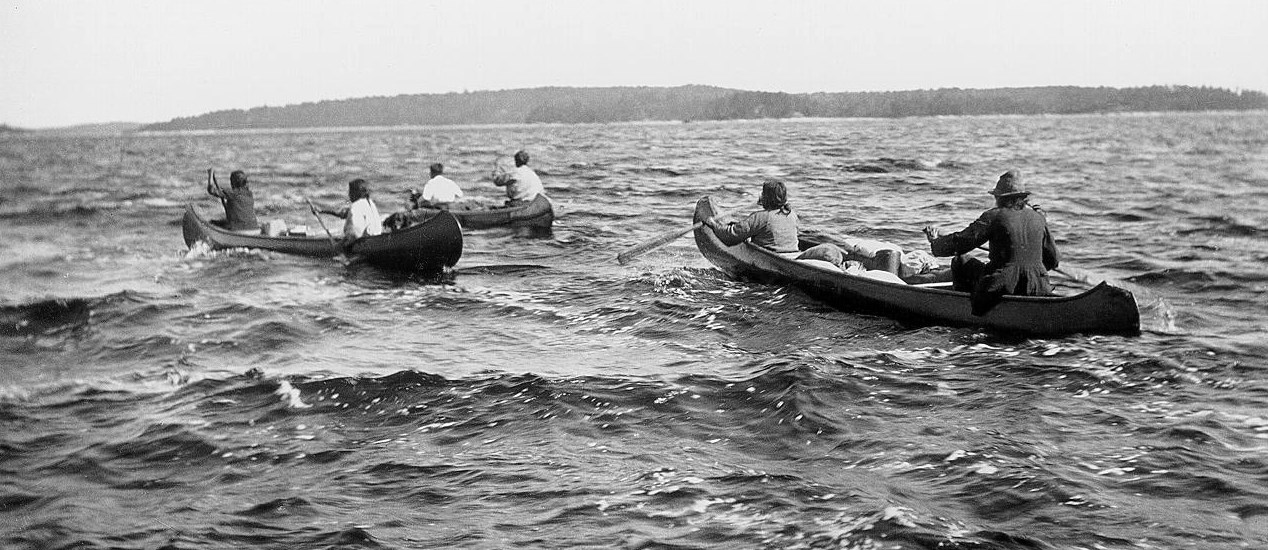Last updated: August 31, 2020
Article
Voyageurs National Park

Historically, the Chippewa (also called the Ojibwe or Ojibwa) were the main American Indian group who lived in what is now Voyageurs National Park. Using archeology, history, and oral history, researchers have started to understand the past of the Bois Forte people, the primary local Chippewa group.
Midwest Archeological Center archeologist Jeffrey Richner has led many projects inventorying archeological sites in the park. During these inventories, he discovered historic sites relating to the Bois Forte occupation dating to the late 19th century and early 20th century. Treaties from the mid-19th century were supposed to have restricted the Bois Forte people to life on a reservation away from park lands. This unexpected discovery encouraged Richner to investigate further. The results of this work provide a clearer picture of Bois Forte social structure, land use, and settlement in the park.
History
The Bois Forte Chippewa (Ojibwe) numbered roughly 600-1000 people from the mid-1800s to the present day. A portion of this population, averaging around 100-200 people, occupied what is now the park from at least the 1880s until 1910. Divided into four bands, some of the Bois Forte stayed in the park seasonally while others were permanent residents.
Despite increasing pressure from white settlers, waves of deadly diseases, major environmental change, and loss of traditional beliefs and lifestyles, a large number of Bois Forte stayed in the park until 1920. By the 1930s, only some scattered Bois Forte people lived in the park permanently. However, large numbers returned seasonally for blueberry picking. The scattered individuals that remained belonged to families that had long histories within the region.
The Bois Forte Chippewa (Ojibwe) numbered roughly 600-1000 people from the mid-1800s to the present day. A portion of this population, averaging around 100-200 people, occupied what is now the park from at least the 1880s until 1910. Divided into four bands, some of the Bois Forte stayed in the park seasonally while others were permanent residents.
Despite increasing pressure from white settlers, waves of deadly diseases, major environmental change, and loss of traditional beliefs and lifestyles, a large number of Bois Forte stayed in the park until 1920. By the 1930s, only some scattered Bois Forte people lived in the park permanently. However, large numbers returned seasonally for blueberry picking. The scattered individuals that remained belonged to families that had long histories within the region.

Project Methods
This project relied on information from a variety of sources, including historical records, archeological data, and oral histories. Although most of the available sources provide only limited information, when dozens of fragments of evidence are pieced together, the result is a detailed account of Bois Forte life.
The Bois Forte site on Chief Wooden Frogs Island can serve as an example. It is recorded by several photographs, historic maps, and limited archeological study. This location, combined with other sites throughout the park, provides important data regarding Bois Forte settlement in the late historic era.
This project relied on information from a variety of sources, including historical records, archeological data, and oral histories. Although most of the available sources provide only limited information, when dozens of fragments of evidence are pieced together, the result is a detailed account of Bois Forte life.
The Bois Forte site on Chief Wooden Frogs Island can serve as an example. It is recorded by several photographs, historic maps, and limited archeological study. This location, combined with other sites throughout the park, provides important data regarding Bois Forte settlement in the late historic era.
The earliest known photo of the site is from 1913. The site was not occupied when it was photographed. This photo is very important because it provides the best early image of a Bois Forte settlement that is connected to a known site location within the park. The image shows the frameworks of wigwams, tipis, and a log house.

The 1926-1928 Rainy Lake reference maps depict five structures at the site. All of these structures match up with a 1927 aerial photograph.
Limited archeological investigation of the site was done in 1996. Using several 1947 photographs of log houses as a guide, the remains of three of these structures were relocated. Remnants of a fourth structure might have been identified. The three structures and associated artifacts were mapped.
Limited archeological investigation of the site was done in 1996. Using several 1947 photographs of log houses as a guide, the remains of three of these structures were relocated. Remnants of a fourth structure might have been identified. The three structures and associated artifacts were mapped.

Conclusion
A minimum of four bands resided in or near the park from the 1880s into the early 20th century. Artifacts found during the archeological work mark their presence on the land. Matches of names (and locations) of individuals and families across documentary sources, photographs, and oral histories allow us to trace these bands through time. While the Bois Forte certainly lived in the area before 1880, we currently lack evidence to follow the groups back further in time.
A minimum of four bands resided in or near the park from the 1880s into the early 20th century. Artifacts found during the archeological work mark their presence on the land. Matches of names (and locations) of individuals and families across documentary sources, photographs, and oral histories allow us to trace these bands through time. While the Bois Forte certainly lived in the area before 1880, we currently lack evidence to follow the groups back further in time.

Tags
- voyageurs national park
- archeology
- archaeology
- minnesota
- midwest region
- midwest archeological center
- homesite
- village
- house
- native american
- american indian
- wood forte chippewa
- ojibwe
- ojibwa
- research
- documentation
- excavation
- inventory
- historical records
- historical photographs
- historical maps
- midwest nps
- midwest
- nebraska
